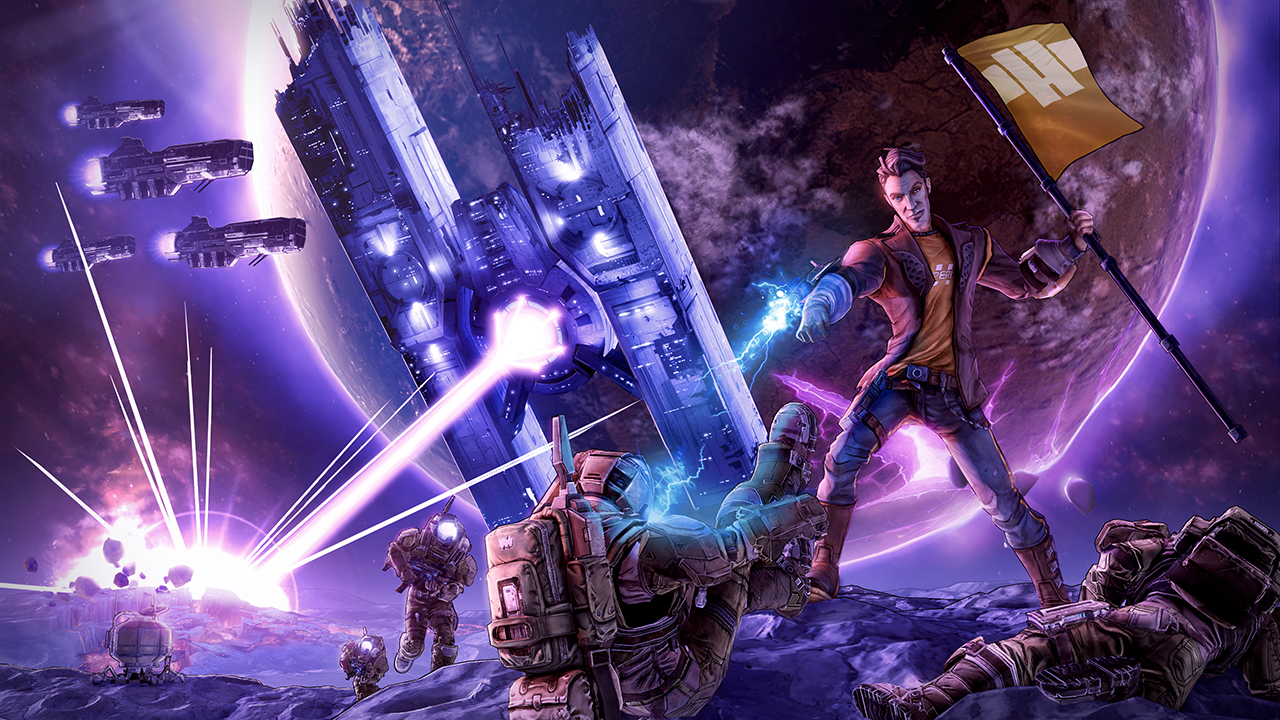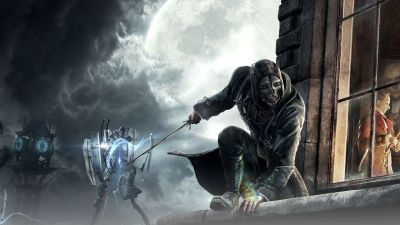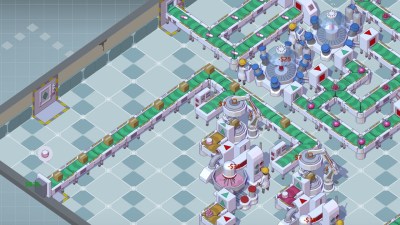I’ve said it before, but it’s worth repeating: I love the Borderlands franchise.
Gearbox developed a really good idea back in 2009 with the first installment, improved it tenfold with its sequel in 2012, and won over the hearts and minds of millions of players. The story felt original, the places were one-of-a-kind, the gameplay was easy to learn and incredibly engaging, and above all the writing was fantastic. Borderlands is the franchise that got me interested in the FPS genre: Mass Effect may have lit the torch, but Borderlands carried it. I spent a lot of time playing both solo and co-op modes, experiencing each new Vault Hunter and their fresh skill sets, and making sure I covered every side and main story quest that was available so that I could give you the most in-depth impression of Borderlands: The Pre-Sequel! that I can.
So, let’s jump in.
The Pre-Sequel!, as its name denotes, takes place in the space between Borderlands 1 and 2. We get to learn the back story behind Handsome Jack - arguably one of the most sadistically humorous, well-written villains in recent years. We get to see the transformation of a piddling little worker with no self-esteem caught within in the great machine of the Hyperion Corporation rise into the ultimate force to be contended with by the Vault Hunters in Borderlands 2. I did notice some minor continuity issues here and there, though you’re bound to run into those whenever you pull a Quentin Tarantino-type telling. But none of them were so bad as to wholly ruin my experience. I did, however, find it just this side of unbelievable that the Borderlands 1 Vault Hunters conveniently forgot that (spoiler alert!) it was their fault Jack turned into a maniacal bastard bent on destroying them and waking the Warrior – or rather, that it was Lilith’s fault.
The Pre-Sequel itself is fairly short, only 20-30 hours depending on how thorough you are at completing side quests, looking for secrets, opening up containers, and killing every enemy that spawns.
One of the biggest complaints about the franchise from the community at large is the flawed waypoint system and the seemingly endless amount of time you can spend wandering between Point A and Point B, with nothing in between to keep your attention. Personally, I’ve never felt like this was a real detriment to the game play or as irritating as the general populous seems to feel it is. In the earlier, easier game modes, it’s no big effort to run through an area camped by mobs in order to get to the other side, as they won’t do much damage to you or follow you past a pre-determined point.
In the later stages of the game, like Ultimate Vault Hunter mode, choosing to fight those enemies gives you a shot at better loot – and who doesn’t want that? If you want to look at it another way, being teleported to your desired destination immediately would reduce game difficulty in the later stages, and you’d never spend time exploring all the nooks and crannies, which in this franchise are where some of the funniest bits lie in wait for you.
In exploring the new map areas of the Hyperion station and Pandora’s moon, Elpis, you’ll find the same style that was so distinct in Borderlands 2 painting a picture of alien landscapes and bedraggled bandit camps. You won’t find anything groundbreaking here, but you will see a continuation of a successful and recognizable style. Previous titles have been criticized for their bugs, and though I never experienced any bugs during my time with either Borderlands or Borderlands 2, Borderlands: The Pre-Sequel! did have a few hiccups with enemies getting caught on, under, or inside the maps. This was only a minor annoyance, since it didn’t allow me to officially end a battle sequence, but since the enemy couldn’t target me either, it wasn’t as though I was being shot at by something I couldn’t see. The only other glitch I experienced was falling through the map at one particular point, though that didn’t trigger an auto-death as it would normally. Athena simply stood on an invisible platform while the map loomed above, requiring a force quit. This only happened once, so I can’t say that my experience was ruined by this at all – it was simply a minor annoyance (a far cry from some of the quest-breaking glitches encountered in Skyrim, for example).
The story is where Borderlands: The Pre-Sequel! really shines, just like its predecessors. Minor plot holes aside (and I mean really minor), we watch as Jack is transformed from a spineless twit into the angst-driven megalomaniac we know and love. It was great to see Jack in the beginning running for his life and getting the crap beaten out of him, because at this point he was just a regular corporate guy, low on the totem pole and not destined for anything awe inspiring. It was even more interesting to watch the subtle and very powerful shifts in his thoughts and actions as the story progressed, from the strange exhilaration he feels after he kills a man (for what I assume is the first time in his life), to the man who can barely control his anger and impatience, barking orders through gritted teeth and telling you to kill anybody who gets in your way as you draw nearer to the Vault. It’s an enrapturing saga, short as it is, and it’s definitely worth experiencing.
Another aspect of the storytelling that I really enjoyed was that the player-character Vault Hunter interacted with the dialogue of the NPCs. In previous games, you were a silent protagonist that only said witty things during combat. Now, the Vault Hunters have been given a bit more personality and it livens up the dialogue in a way that allows replayability without being boring. This was further accentuated when starting a new play through on True Vault Hunter mode with harder enemies and better loot, the voiceover dialogue in the beginning changed to allow the fact that you, as the player, had finished the game, and gave me a fourth wall-breaking giggle fit. Actually, the best line of the whole game occurs within the first five minutes of play during True Vault Hunter mode. I won’t ruin it for you, but it was almost fall-off-the-couch funny.
- New places.
- Familiar faces.
- Same awesome co-op action.
- New enemies.
- Gorgeous scenery.
Elpis is the equivalent of Earth’s Australia. It was never fully explained if Elpis used to be a prison colony, but regardless of its colonization origins, the majority of the moon’s populace hails from down under. This decision was likely made because 2K Australia picked up the tab on creating Borderlands: The Pre-Sequel! and so the local voice actors were, shockingly, Australian, but it does lend a certain “newness” to the franchise and makes Elpis really feel like a place I hadn’t experienced before. This was accentuated many times, as the side quests tended to have a distinctly Australian style, from quoting nearly line for line the words of “Waltzing Matilda,” to ragging on the absurdly strange rules of cricket- sorry, snicket, to a cameo appearance of one of my childhood idles, Steven Irwin, and his crusade to save the native species of Elpis. Australian humor seems to go hand-in-hand with the Borderlands sarcastic wit, which makes The Pre-Sequel! a successful, happy marriage.
I will say the one area in the story where I was a bit disappointed was Angel’s lack of presence throughout. Angel has played an integral part in both previous titles, and though she appears in a few Echo recordings and once as a photograph on Jack’s desk, she’s been left largely forgotten. I had been hoping that we would see a bit of Angel’s role in Jack’s rise to dominance, since she was clearly a very powerful figure that he was able to manipulate early on. I had a theory that perhaps Jack’s madness was driven partly by his need to protect her, but in the end it seemed like Angel had very little to do with his overall development and I found that to be a bit of a letdown.
The meat and potatoes of any Borderlands game are the playable Vault Hunters and their skill customizations. Following the successful model of previous games, each Vault Hunter has three skill trees that focus on three different aspects of combat that can be mixed and matched to suit a particular play style, current equipment, or upcoming raid boss. The four new Vault Hunters are: Athena the Gladiator, Wilhelm the Enforcer, Nisha the Lawbringer, and CL4P-TP the Fragtrap, with a fifth character coming next week. Most of my solo play was spent with Athena (she’s who I beat the campaign with) while most of my co-op play was with Claptrap, though I did experience Wilhelm and Nisha to see how their skill trees worked with my particular play style. Theory crafters are already hard at work developing “the best character” but in reality this game is best experienced first hand, figuring out what you like and don’t like about a skill tree and trying new combinations to see what works best for you. Personally, Athena and Wilhelm are fantastic for solo play, with Nisha and Claptrap coming in as close seconds. No one character is particularly better or worse than another. The reason for this is because it feels like 2K spent a lot of time developing synergies between skill trees and equipment that allow for an even deeper level of customization than previous titles. It’s exactly the same formula, so it may not seem like it feels any different, but winding your way through the skill trees is one of the most engaging parts of Borderlands: The Pre-Sequel!.
I’ve read a lot of talk about Claptrap being a “fluff” character — he’s just there for people to be annoying with during co-op play, but I found him a lot of fun. He’s a bit of a mix of all the Vault Hunters from all previous titles, as well as he own bit of fun. His VaultHunter.exe action skill is a roulette wheel that may sometimes annoy you and your teammates, but he’s good for a giggle and actually can be pretty darn powerful while he’s at it. I would like to see if anyone has experimented in a co-op game with four Claptrap units, as VaultHunter.exe can affect all members of the party at one time. I’m assuming the development team thought of this possibility, but I’d love to see the mayhem in action!
The addition of lasers and cryo damage to the weapon repertoire is just as fun as it sounds, adding new gameplay elements and strategies to a familiar surrounding. Initially, I was worried that having to constantly monitor the need for oxygen via an Oz kit would be a hassle, but it was never felt that way. There are plenty of O2 vents and O2 generators to trigger that you’ll rarely find yourself suffocating unless you’re extremely inattentive. Some Oz kits even provided bonuses for the amount of O2 missing from your tank, for those who like to live dangerously. Again, the addition provides just enough “newness” to the game to keep it fresh and engaging without straying from what makes the franchise so enjoyable. Cameos by past characters are appreciated, and the new characters make their mark just as well as the old. Eridium has been replaced by Moonstones, and these Moonstones can be spent on more than just SDUs and raid bosses, and you can still get a constant flow of Golden Keys to up your arsenal.
Some people have said The Pre-Sequel! is “just another Borderlands.” It’s then that I look at the Call of Duty franchise, shrug my shoulders, and smile. Borderlands: The Pre-Sequel! has continued the successful franchise of mayhem with another excellent game, bringing enough newness to an old formula that makes it feel like its own stand-along game rather than just a DLC add-on. The engaging story carries with it the deep customization levels and satisfies the loot-grinder in all of us, and the decidedly Australian hijinks are sure to delight. It’s not without its few bugs, but I don’t think we’ve ever seen a new release without its fair share of glitches here and there. If you like the franchise, it’s an absolute must-have addition that you will play through just as many times as you played Borderlands 2.




